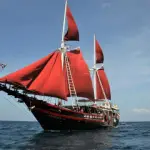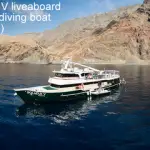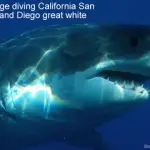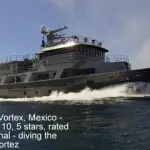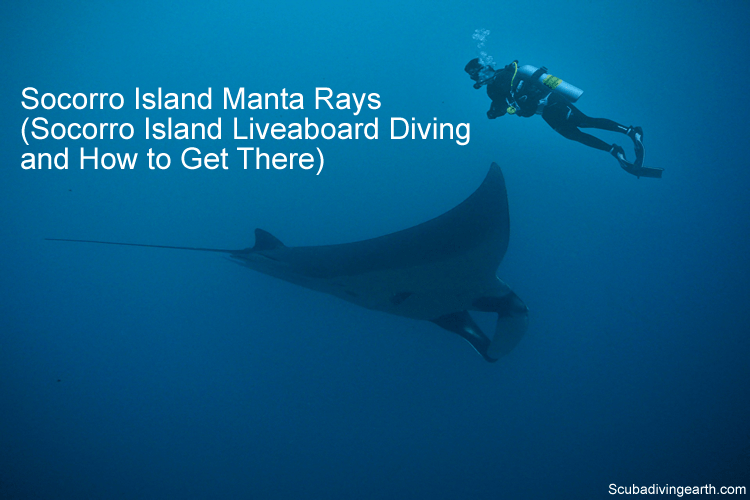
Socorro Island diving is about large creatures including majestic Oceanic Manta Rays
Socorro Island is a part of a small group of volcanic islands in the Pacific Ocean and is the best known island of the ‘The Revillagigedos Archipelago.’ Known for big animal scuba diving and off the beaten track. Ideally suited for advanced scuba divers, the Socorro Islands are the perfect spot to dive with majestic manta rays.
Socorro Island’s giant pacific manta rays can grow to have wingspans up to 7 metres (23f). Scuba diving with Socorro Island mantas can only be achieved by Socorro Island liveaboard as the islands are 390 kilometres (240m) off the main land, making it a 24 hour boat ride from Cabo San Lucas.
The best way to dive the Socorro Islands, Mexico is by a scuba diving liveaboard. You can check the latest and best deals on liveaboards using the following window:
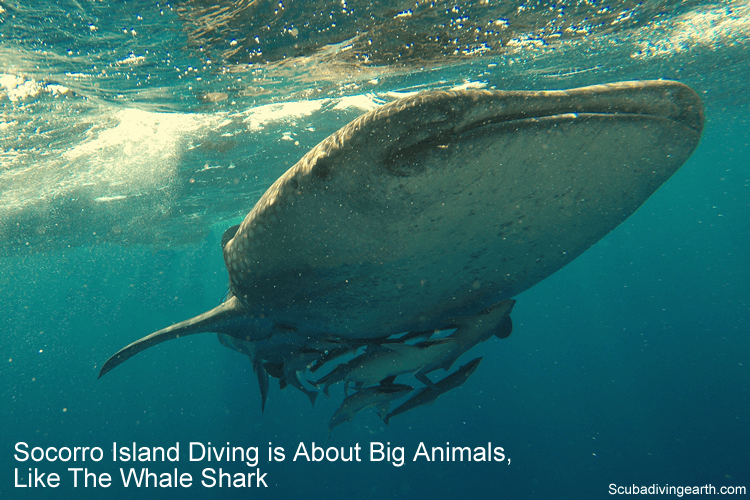
Socorro Island diving – A bucket list trip for many scuba divers
If you’re into diving with big animals and if you like a bit of adventure with your scuba diving, Socorro Island is the perfect spot for you to scuba dive.
As the islands are more than 480 kilometres (300 miles) off the coast of Mexico, all diving at Socorro Island is carried out from a liveaboard dive boat. It’s a 24 hour boat trip from the main land.
There are no hotels on any of the Revillagigedos Archipelago islands. This means there’s no place to stay other than on a Socorro Island liveaboard boat. Your liveaboard boat will be your floating hotel.
The big animals you are likely to encounter at Socorro Island include:
- Whale sharks.
- Hammerhead sharks.
- Silky sharks.
- Silvertip sharks.
- Whitetip sharks.
- The occasional tiger shark.
- Humpback whales.
- Dolphins.
- Many big pelagics.
- Plus the majestic and beautiful Pacific manta rays.
The Socorro Island pelagic fish include yellowfin tuna, wahoo and large schools of jacks.
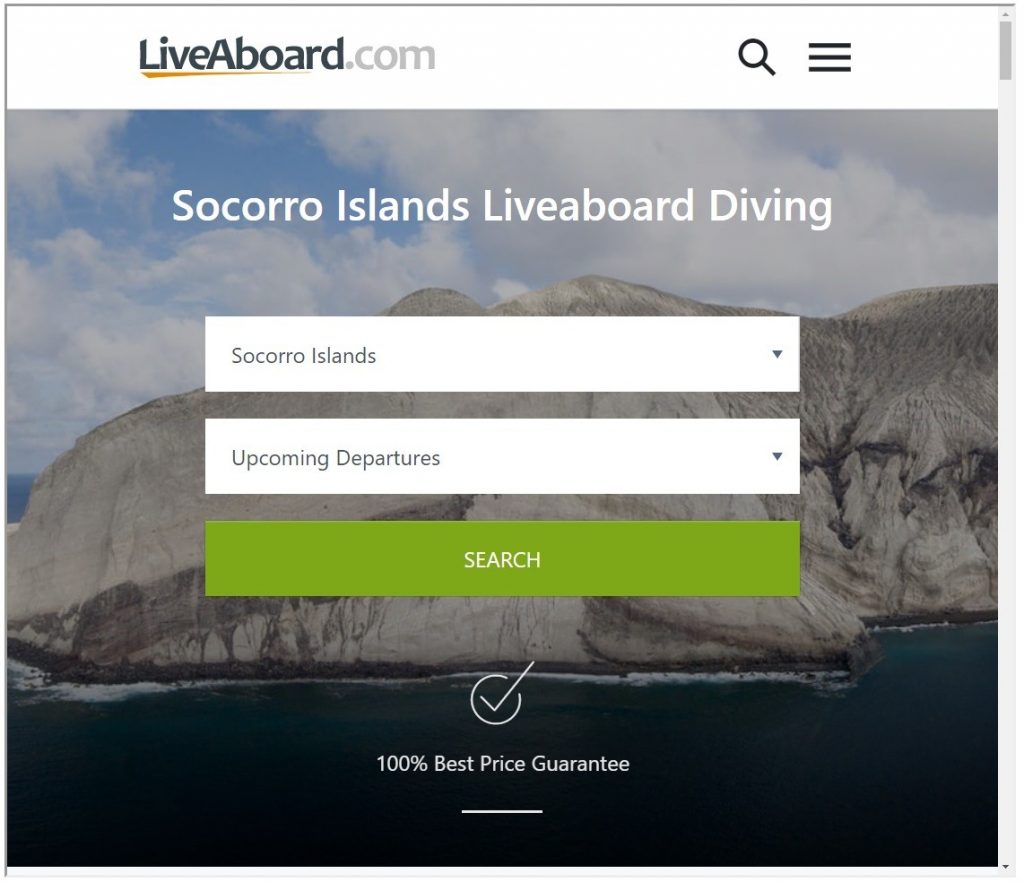
Are manta ray sightings guaranteed at Socorro Island?
You are not guaranteed to see manta rays diving Socorro Island, but there’s a good chance you will see them? Manta rays are present throughout the year. But depending on your diving preference some times are better than others.
The best time to scuba dive Socorro Island Mexico
The diving season for Socorro Island is between November and May only. Outside of these months the seas in the region become too rough to scuba dive.
If you prefer warmer waters, the best time is when the water temperature is between 23-26°C (73-79°F).
The warmer water temperatures around Socorro Island include November through to early January, which are actually the months that are better to see manta rays and sharks too.
The winter months of late January to early April is the best time to see humpback whales. At this time of year the water temperature is between 21-23°C (70-73°F).
The humpbacks visit the area to calve. If you visit in this season you are likely to see humpbacks breaching. You are also likely to hear their sounds of singing underwater when you’re diving.
Summary of the best times for Socorro Island liveaboard diving
- November to May – Calmest seas.
- Water temperatures in November of 28°C (82°F).
- The water temperatures in February of 21°C (70°F), that’s drysuit diving temperatures for me.
- Water temperatures in May of 25°C (77°F).
- Winter months (January to April) – Humpback whales and more mantas.
- July to December – Whale sharks.
Socorro Island manta rays video
Socorro Island manta rays are one of the big draws for scuba divers. You’ll see they feature well in the video below, alongside, breaching whales, whitetip sharks, Galapagos sharks, hammerhead sharks.
Don’t miss the “shark nest” at the end! Spectacular Majestic Giant Pacific Ocean Chevron Manta Rays. School of Hammerhead Sharks, Black Manta, Galapagos Shark, Remora sucker fish, Silvertip Sharks and more at Revillagigedo Archipelago, (Socorro, San Benedicto, Roca Partida) 435 miles (700 km) off the west coast of Mexico. A ray circles the videographer, hits him in the face to scrape off a remora! In a rare display of natural body function, ray lays a poop bomb! Depth 65 – 85 feet (20 – 25 metres), water temperature 68 – 74F (20 – 23C), nitrox. Solmar V yacht seen at sunset. January 2012. (c) Craig Capehart
The manta rays a Socorro islands are the for the angel fish to pick parasites off their bodies. Once cleaned, the manta rays head off leaving the angel fish behind until their next visit.
Socorro scuba diving is for advanced divers only
Due to the strong and unpredictable currents around Socorro Island, the diving is suitable for intermediate to advanced scuba divers only.
This means that if you’are a novice or a beginner scuba diver, Socorro Island is not the place for you to dive. This is of course until such time as you gain more relevant scuba diving experience.
But there’s nothing wrong in adding Socorro Island manta rays to your future ‘scuba diving bucket list.’
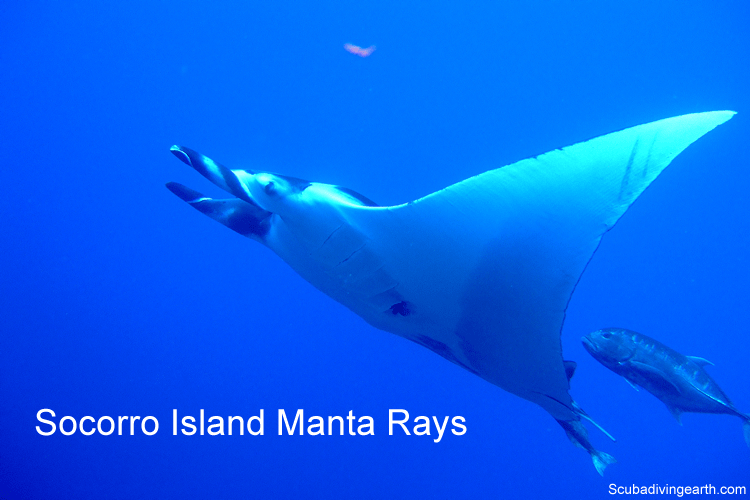
Socorro Island Manta Rays
The manta rays at Socorro Island are Giant Pacific Ocean Manta Rays.
These ocean giants can grow up to 7 metres (23 feet) in wingspan. These larger manta rays can weigh in at over 3,000kg (6,600 lbs).
Manta rays at Socorro Island are completely harmless creatures and are larger than their reef manta ray cousins.
To scuba dive with the Socorro Island manta rays you have to join a liveaboard boat.
The best known of all the Revillagigedos archipelagos is Socorro Island. This region is sometimes referred to as ‘The Galapagos of Mexico.’ In fact as mentioned in this article, you will see Galapagos sharks there.
Socorro Island Scuba diving isn’t for its colourful reefs. It is instead for the large animal interactions there. The scenery underwater is mostly volcanic rock formations and pinnacles.
You had better love scuba diving with sharks, because you’ll not only encounter the famous Socorro Island manta rays, but also many sharks too.
Where is Socorro Island?
The four islands of the archipelago lie approximately 390 kilometres (240 miles) southwest of Cabo San Lucas.
Cabo San Lucas is on the southern tip of the Baja Peninsula, Mexico, which is where you pick up your liveaboard boat trip.
A review on Trip Advisor of Socorro Island includes comments like:
‘At least 6 mantas and they would come so close you touch them if you wanted to. They would swim by and look you in the eyes. We did 3 dives here and it was incredible…‘ and then
Review from Trip Advisor
‘We then moved to Roca Partida. This place not only delivered mantas, it also had schooling hammerheads, Galapagos sharks, white tips, silver tip sharks, yellowfin tuna, Dolphins.’
Review from Trip Advisor
Socorro Island history and information
Socorro Island is the largest of the four islands of this volcanic archipelago in the Pacific Ocean.
The island was discovered by the Spanish explorer Hernando de Grijalva in 1533. The Islands are owned by Mexico and Socorro Island has been home to a Mexican Naval Station since 1957.
As a result of the proximity of the Mexican military, Socorro Island is occasionally closed to divers due to military operations.
A large percentage of the original vegetation of the Revillagigedo Islands has been destroyed over the last 50 years. This is as a result of the introduction of domestic sheep. This was done on the island in the 1960’s and 70’s, and has contributed to the loss of at least 1% of the native vegetation.
Feral cats have also unfortunately contributed to the reduction of the native bird populations on the Islands of Revillagigedo. But it is also the naval officers and their families, who are responsible for the gradual destruction of the vegetation too.
The islands have received federal protection since 1994, yet an adequate management program is needed to help protect the endemic flora and fauna.
The other islands of The Revillagigedos Archipelago are San Benedicto, Roca Partida and the outer island Clarion Island.
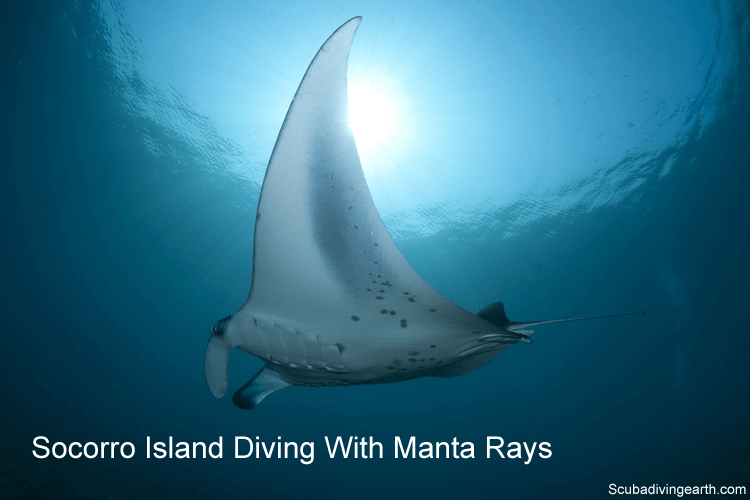
Revillagigedos Archipelago diving and the dive sites
Socorro Island diving
Socorro Island Cabo Pearce dive site
The Socorro Island Cabo Pearce dive site is indicated on the surface by a thin finger of rock. This rock stretches out from the east coast of the island.
Cabo Pearce is a reef that extends out into the prevailing current. This area is always frequented by dolphins and they are often on the surface to greet the liveaboard boat on arrival.
It’s not often that dolphins hang around with scuba divers in most places where they are seen. However, around Socorro Island they seem to like to interact with scuba divers.
Quite often the dolphins are still there when you enter the water. They sometimes stay around for the whole dive.
So if you’ve also always wanted to scuba dive with dolphins, Socorro Island is also the place to head to.
At the Socorro dive site you’ll experience quite a strong currents. This means the only way to experience this dive site is to protect yourself from the strongest current in amongst the rocks.
You are likely to see scalloped hammerheads here, which is usually in a large school. You may also experience silky sharks as well as the Galapagos sharks.
If you are visiting in the winter months you may also catch a glimpse of a humpback whale too.
But of course the star of the show is the Socorro Island manta rays at Cabo Pearce.
Punta Tosca dive site Socorro Island
The Punta Tosca dive site near to Socorro Island is known for encounters with humpback whales at the right time of year. This is in addition to encounters with dolphins, plus the possible tiger shark.
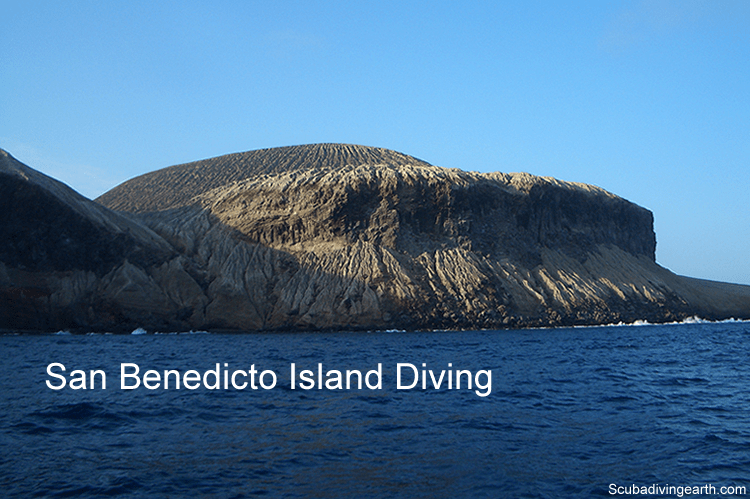
San Benedicto island diving
The San Benedicto Island is the third largest in the Revillagigedos Archipelago group of islands.
It’s likely you’ll see similar large underwater animals that you experience at Socorro Island. But San Benedicto Island diving is renowned for the quality of manta ray encounters there.
If you are lucky, this will not just be a passing manta or two, but instead it will be prolonged and close-up interactions with several Giant Pacific Manta Rays.
At this dive site they come to be cleaned by Clarion angel fish.
This dive site is also visited by hammerhead sharks, whitetip sharks, silky sharks, the possible tiger shark, whale sharks if you’re lucky and the friendly dolphins too.
But then you may have a background compliment of whale song by the Humpback whales too. Which is almost guaranteed to send shivers down your spine.
One of the main features at the San Benedicto Island dive site is The Boiler. The Boiler is a larger pinnacle which rise up from the ocean bed at 50 metres deep (165 feet), to within 6-7 metres (20 feet) of the ocean surface.
This is a manta ray cleaning station, where the Clarion angel fish are keen to clean the visiting Pacific Ocean manta rays.
There can be few manta ray experiences in the world that rival this region, both in terms of the size of the manta rays and for the intimacy of the encounters.
On the surface around The Boiler you’ll see what looks like a boiling sea, as the currents swirl around the top of this pinnacle.
You don’t need to dive too deep at this dive site and certainly no more than 30 metres (100 feet). This is because most of the action is nearer to the surface.
San Benedicto Island diving video
In the video below, which was taken on The Boiler, San Benedicto Island, you’ll spot whitetip reef sharks, dolphins, a moray eel, hammerheads and of course manta ray closeups.
Socorro Island diving information
More information about Socorro Island and the Revillagigedos Archipelago to help you plan your dive trip of a lifetime.
It’s worth noting there are few places around the world that can boast such vast marine riches.
This means that the limited number of spaces on the liveaboard cruises fill up early. It is therefore advisable to book well in advance of your proposed trip to Socorro Island.
Socorro Island climate and weather
The climate around this Pacific archipelago is tropical. The climate is subhumid with summer rains throughout the archipelago. Subhumid means it can be slightly to moderately moist.
However, in general, the four islands are dry, with a mean annual precipitation of 600mm (23.6 inches) per year.
Socorro Island water visibility
The visibility throughout the liveaboard season between November and May can vary greatly.
The lowest water visibility is during the months of November and December. During these months the water visibility can drop from the usual 30-40m (100-131 feet) to around 15-20 metres (50-66 feet).
Dive depths at Socorro Island
The depth of the dives around Socorro Island range between 10-30 metres (33-100 feet).
Surface conditions and currents around Socorro Island
The surface conditions can become choppy at times.
The currents when diving can be moderate to strong at times. This is why the scuba diving, apart from its remoteness, is recommended for intermediate to advanced dives only.
Number of dive sites at The Revillagigedos Archipelago
There are twelve dive sites in total in the region. But even though there’s only a small number of dive site, you’ll never get bored of diving them.
With such a variety of large large sea creatures around you on most of the dive sites for most of the time, what appears to be a limited number of dive sites isn’t a problem at all.
How to get to Socorro Island
The only way to scuba dive Socorro Island is by liveaboard boat. To get there you need to first fly to Mexico. You can fly to Los Cabos International Airport.
From there you need to get to Cabos San Lucas, which is where you’ll board your liveaboard boat for typically 8-9 days in total.
Two of these days will be spent getting to Socorro Island and back again. This leaves you with 7 days of great diving to see manta rays and much more.
Socorro Island liveaboard boats available for trips
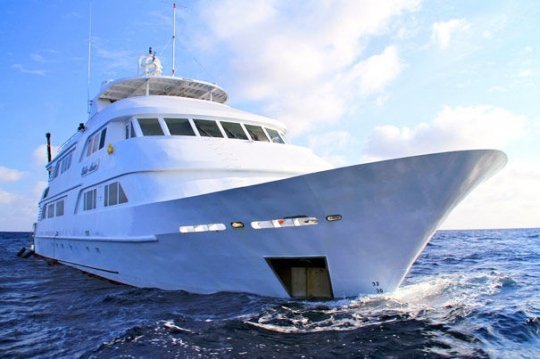
Socorro Island liveaboard – The Nautilus Belle Amie
The Nautilus Belle Amie is a large stable boat standing in at 41 metre (135 feet). She is a single steel-hulled liveaboard boat.
The Nautilus Belle takes a maximum of 32 guests on board. All cabins on board have private bathrooms. The food served during your diving safari is a mix of Mexican and western style cuisine .
The boat is equipped with Nautilus lifeline lost diver devices for safety reasons. This is to protect scuba divers in a remote area with strong currents.
If you are a rebreather diver, this facility is available for you on this liveaboard boat.
On an eight night trip you will do up to four dives per day making a maximum number of dives of 18. However, the 10 night dive trip allows for up to 21 dives in total.
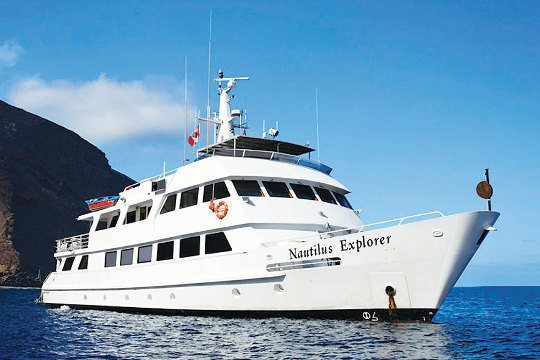
Socorro Island liveaboard – Nautilus Explorer liveaboard
The Nautilus Explorer is a smaller liveaboard boat. It is also a single steel-hulled boat measuring 35 metres (116 feet) in length.
All the cabins have private bathrooms and some have TV and DVD. The Nautilus Explorer can accommodate up to 27 divers.
There is an air-conditioned saloon, a dining area and sundecks on this well equipped liveaboard boat.
The saloon features comfortable seating, an extensive reading library and a well-stocked bar for its passengers.
This liveaboard boat is also equipped with Nautilus lifeline lost diver devices for safety reasons. This is to protect scuba divers in a remote area with strong currents.
The eight night dive trip includes up to four dives per day, with a maximum of 22 dives in total on the trip to Socorro Islands. Whereas the 10 night trip includes up to 27 dives in total.
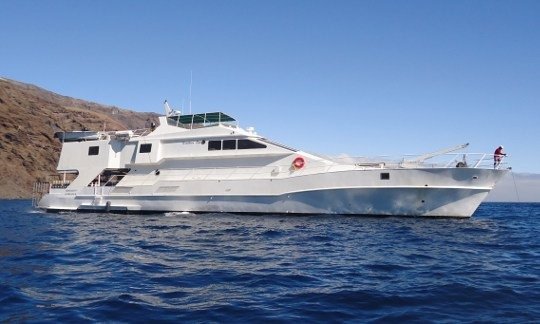
Socorro Island liveaboard – The MV Sea Escape and MV Southern Sport dive boats
There are two further liveaboards offering dive trips to Socorro Island to see manta rays. These are the 34 metre (112 feet) MV Sea Escape liveaboard boat and the 35 metre (116 feet) MV Southern Sport liveaboard dive boat.
The MV Sea Escape is an aluminium hulled boat. For safety it has individual lost diver devices. The MV Sea Escape has a capacity of 18 guests. The vessel has some en-suite cabins.
The MV Southern Sport has a re-compression chamber on-board, which is unusual for a liveaboard dive boat. Like the MV Sea Escape, the MV Southern Sport is also an aluminium hulled boat too.
The MV Southern Sport liveaboard also has the provision of individual lost diver devices for diver safety.
This liveaboard accommodates up to 18 guests onboard and the cabins have private bathrooms.
I hope you enjoyed this article about Socorro Island manta rays
I’d love to hear from you. Tell us about your adventures of diving and snorkeling, in the comments below. Please also share your photos. Either from your underwater cameras or videos from your waterproof Gopro’s!
If this article hasn’t answered all of your questions. If you have more questions either about snorkeling or types of scuba diving (or specifically about Socorro Island manta rays), please comment below with your questions.
There will also be many more articles about scuba diving (and snorkeling) for you to read and learn about these fabulous sports.
Have fun and be safe!

